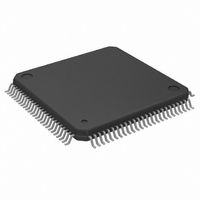MC68EC020AA25 Freescale Semiconductor, MC68EC020AA25 Datasheet - Page 126

MC68EC020AA25
Manufacturer Part Number
MC68EC020AA25
Description
IC MPU 32BIT 25MHZ 100-QFP
Manufacturer
Freescale Semiconductor
Datasheet
1.MC68EC020AA16.pdf
(306 pages)
Specifications of MC68EC020AA25
Processor Type
M680x0 32-Bit
Speed
25MHz
Voltage
5V
Mounting Type
Surface Mount
Package / Case
100-QFP
Family Name
M68000
Device Core
ColdFire
Device Core Size
32b
Frequency (max)
25MHz
Instruction Set Architecture
RISC
Supply Voltage 1 (typ)
5V
Operating Supply Voltage (max)
5.25V
Operating Supply Voltage (min)
4.75V
Operating Temp Range
0C to 70C
Operating Temperature Classification
Commercial
Mounting
Surface Mount
Pin Count
100
Package Type
PQFP
Lead Free Status / RoHS Status
Lead free / RoHS Compliant
Features
-
Lead Free Status / Rohs Status
RoHS Compliant part
Electrostatic Device
Available stocks
Company
Part Number
Manufacturer
Quantity
Price
Company:
Part Number:
MC68EC020AA25
Manufacturer:
Freescale Semiconductor
Quantity:
10 000
Company:
Part Number:
MC68EC020AA25R
Manufacturer:
Freescale Semiconductor
Quantity:
10 000
- Current page: 126 of 306
- Download datasheet (2Mb)
SECTION 6
EXCEPTION PROCESSING
Exception processing is defined as the activities performed by the processor in preparing
to execute a handler routine for any condition that causes an exception. In particular,
exception processing does not include execution of the handler routine itself. An
introduction to exception processing, as one of the processing states of the
MC68020/EC020, is given in Section 2 Processing States.
This section describes exception processing in detail, describing the processing for each
type of exception. It describes the return from an exception and bus fault recovery. This
section also describes the formats of the exception stack frames. For more detail on
protocol violation and coprocessor-related exceptions, refer to Section 7 Coprocessor
Interface Description. Also, for more detail on exceptions defined for floating-point
coprocessors, refer to MC68881UM/AD , MC68881/MC68882 Floating-Point Coprocessor
User's Manual .
6.1 EXCEPTION PROCESSING SEQUENCE
Exception processing occurs in four functional steps. However, all individual bus cycles
associated with exception processing (vector acquisition, stacking, etc.) are not
guaranteed to occur in the order in which they are described in this section. Nonetheless,
all addresses and offsets from the stack pointer are guaranteed to be as described.
The first step of exception processing involves the SR. The processor makes an internal
copy of the SR, then sets the S-bit in the SR, changing to the supervisor privilege level.
Next, the processor inhibits tracing of the exception handler by clearing the T1 and T0 bits
in the SR. For the reset and interrupt exceptions, the processor also updates the interrupt
priority mask (bits 10–8 of the SR).
In the second step, the processor determines the vector number of the exception. For
interrupts, the processor performs an interrupt acknowledge cycle (a read from the CPU
address space type 1111; see Figures 5-32 and 5-33) to obtain the vector number. For
coprocessor-detected exceptions, the vector number is included in the coprocessor
exception primitive response. (Refer to Section 7 Coprocessor Interface Description for
a complete discussion of coprocessor exceptions.) For all other exceptions, internal logic
provides the vector number. This vector number is used in the last step to calculate the
address of the exception vector. Throughout this section, vector numbers are given in
decimal notation.
MOTOROLA
M68020 USER’S MANUAL
6- 1
Related parts for MC68EC020AA25
Image
Part Number
Description
Manufacturer
Datasheet
Request
R
Part Number:
Description:
Manufacturer:
Freescale Semiconductor, Inc
Datasheet:
Part Number:
Description:
Manufacturer:
Freescale Semiconductor, Inc
Datasheet:
Part Number:
Description:
Manufacturer:
Freescale Semiconductor, Inc
Datasheet:
Part Number:
Description:
Manufacturer:
Freescale Semiconductor, Inc
Datasheet:
Part Number:
Description:
Manufacturer:
Freescale Semiconductor, Inc
Datasheet:
Part Number:
Description:
Manufacturer:
Freescale Semiconductor, Inc
Datasheet:
Part Number:
Description:
Manufacturer:
Freescale Semiconductor, Inc
Datasheet:
Part Number:
Description:
Manufacturer:
Freescale Semiconductor, Inc
Datasheet:
Part Number:
Description:
Manufacturer:
Freescale Semiconductor, Inc
Datasheet:
Part Number:
Description:
Manufacturer:
Freescale Semiconductor, Inc
Datasheet:
Part Number:
Description:
Manufacturer:
Freescale Semiconductor, Inc
Datasheet:
Part Number:
Description:
Manufacturer:
Freescale Semiconductor, Inc
Datasheet:
Part Number:
Description:
Manufacturer:
Freescale Semiconductor, Inc
Datasheet:
Part Number:
Description:
Manufacturer:
Freescale Semiconductor, Inc
Datasheet:
Part Number:
Description:
Manufacturer:
Freescale Semiconductor, Inc
Datasheet:











